cruise control CITROEN C-ELYSÉE 2016 Handbook (in English)
[x] Cancel search | Manufacturer: CITROEN, Model Year: 2016, Model line: C-ELYSÉE, Model: CITROEN C-ELYSÉE 2016Pages: 330, PDF Size: 19.96 MB
Page 4 of 330
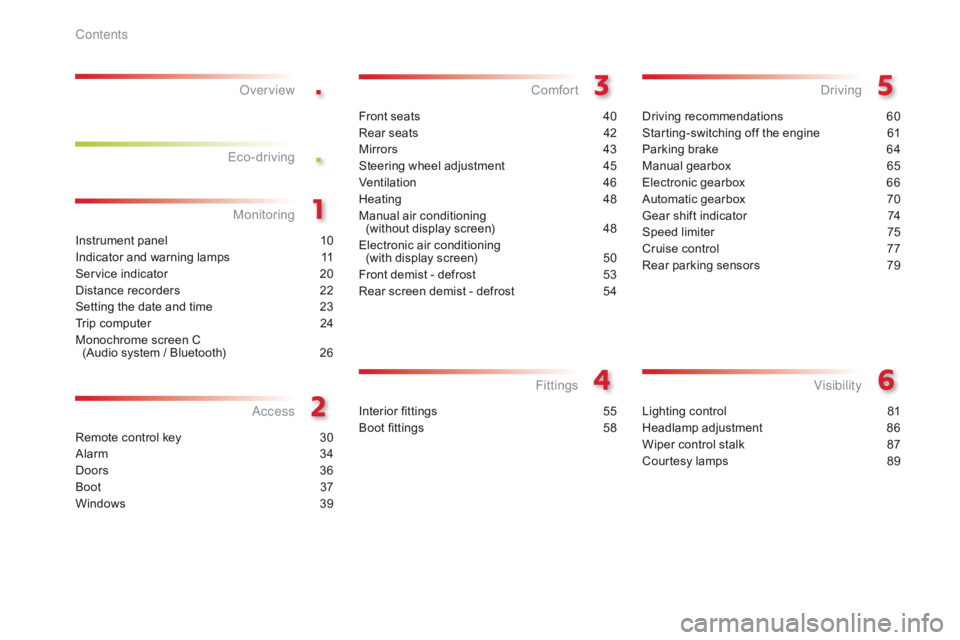
.
.
Instrument panel 10
Indicator and warning lamps
1
1
Service indicator
2
0
Distance recorders
2
2
Setting the date and time
2
3
Trip computer
2
4
Monochrome screen C (Audio system / Bluetooth)
2
6
Monitoring
ove
r view
Remote control key 3
0
Alarm
3
4
Doors
3
6
Boot
3
7
Windows
3
9
access
Front seats 40
Rear seats
4
2
Mirrors
4
3
Steering wheel adjustment
4
5
Ventilation
4
6
Heating
4
8
Manual air conditioning
(without display screen)
4
8
Electronic air conditioning (with display screen)
5
0
Front demist - defrost
5
3
Rear screen demist - defrost
5
4
Comfort
Driving recommendations 60
Starting-switching off the engine
6
1
Parking brake
6
4
Manual gearbox
6
5
Electronic gearbox
6
6
Automatic gearbox
7
0
Gear shift indicator
7
4
Speed limiter
7
5
Cruise control
7
7
Rear parking sensors
7
9
Driving
Lighting control 81
Headlamp adjustment
8
6
Wiper control stalk
87
C
ourtesy lamps
8
9
Visibility
Eco-driving
Interior fittings 5
5
Boot fittings
5
8
Fittings
Contents
Page 7 of 330
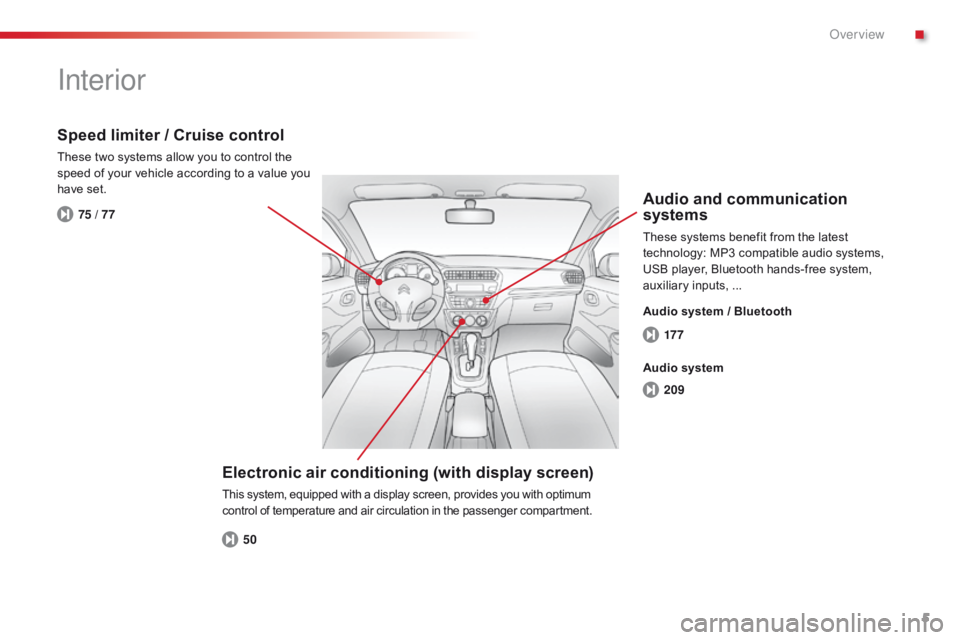
5
C-Elysee_en_Chap00b_vue-ensemble_ed01-2014
17 7
209
50
75 / 77
Interior
Electronic air conditioning (with display screen)
This system, equipped with a display screen, provides you with optimum
control of temperature and air circulation in the passenger compartment.
Speed limiter / Cruise control
These two systems allow you to control the
speed of your vehicle according to a value you
have set.
Audio and communication
systems
These systems benefit from the latest
technology: MP3 compatible audio systems,
USB player, Bluetooth hands-free system,
auxiliary inputs, ...
Audio system / Bluetooth
Audio system
.
Over view
Page 8 of 330
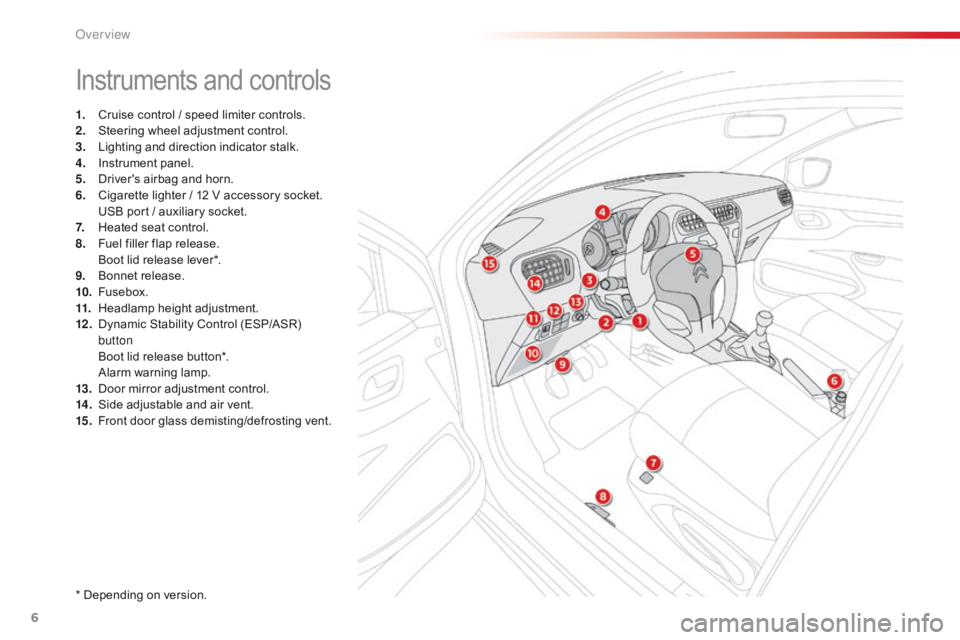
6
C-Elysee_en_Chap00b_vue-ensemble_ed01-2014
Instruments and controls
1. Cruise control / speed limiter controls.
2. Steering wheel adjustment control.
3.
L
ighting and direction indicator stalk.
4.
I
nstrument panel.
5.
D
river's airbag and horn.
6.
C
igarette lighter / 12 V accessory socket.
U
SB port / auxiliary socket.
7.
H
eated seat control.
8.
F
uel filler flap release.
B
oot lid release lever*.
9.
B
onnet release.
10.
F
usebox.
11.
H
eadlamp height adjustment.
12 .
D
ynamic Stability Control (ESP/ASR)
button
B
oot lid release button*.
A
larm warning lamp.
13.
D
oor mirror adjustment control.
14 .
S
ide adjustable and air vent.
15.
F
ront door glass demisting/defrosting vent.
* Depending on version.
Over view
Page 10 of 330
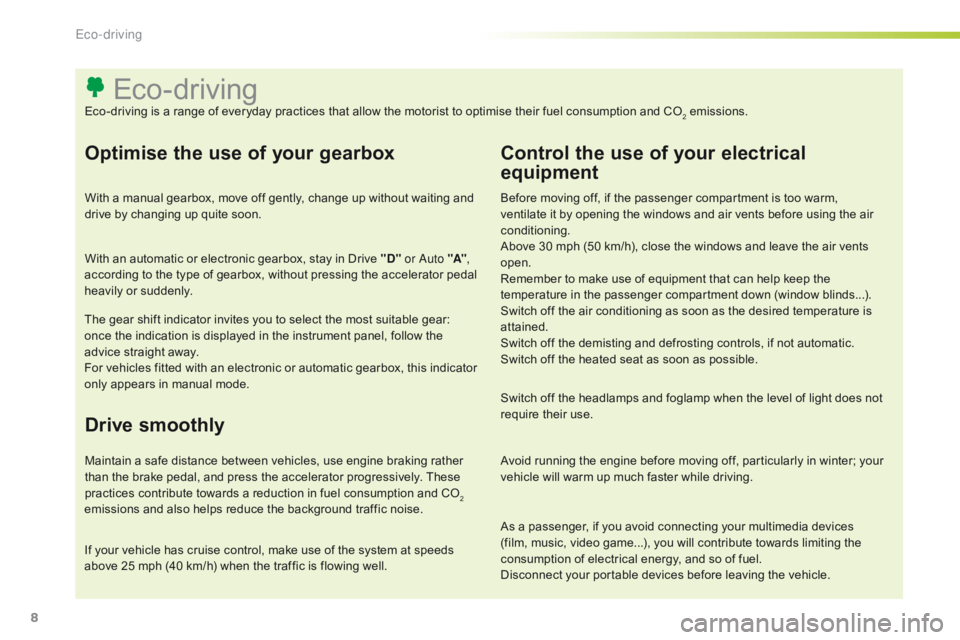
8
As a passenger, if you avoid connecting your multimedia devices
(film, music, video game...), you will contribute towards limiting the
consumption of electrical energy, and so of fuel.
Disconnect your portable devices before leaving the vehicle.
Eco-driving
Eco-driving is a range of everyday practices that allow the motorist to optimise their fuel consumption and CO2 emissions.
Optimise the use of your gearbox
With a manual gearbox, move off gently, change up without waiting and
drive by changing up quite soon.
With an automatic or electronic gearbox, stay in Drive "D" or
a
u
to "A",
according to the type of gearbox, without pressing the accelerator pedal
heavily or suddenly.
The gear shift indicator invites you to select the most suitable gear:
once the indication is displayed in the instrument panel, follow the
advice straight away.
For vehicles fitted with an electronic or automatic gearbox, this indicator
only appears in manual mode.
Drive smoothly
Maintain a safe distance between vehicles, use engine braking rather
than the brake pedal, and press the accelerator progressively. These
practices contribute towards a reduction in fuel consumption and CO
2
emissions and also helps reduce the background traffic noise.
If your vehicle has cruise control, make use of the system at speeds
above 25 mph (40 km/h) when the traffic is flowing well.
Control the use of your electrical
equipment
Before moving off, if the passenger compartment is too warm,
ventilate it by opening the windows and air vents before using the air
conditioning.
Above 30 mph (50 km/h), close the windows and leave the air vents
open.
Remember to make use of equipment that can help keep the
temperature in the passenger compartment down (window blinds...).
Switch off the air conditioning as soon as the desired temperature is
attained.
Switch off the demisting and defrosting controls, if not automatic.
Switch off the heated seat as soon as possible.
Switch off the headlamps and foglamp when the level of light does not
require their use.
Avoid running the engine before moving off, particularly in winter; your
vehicle will warm up much faster while driving.
Eco-driving
Page 12 of 330
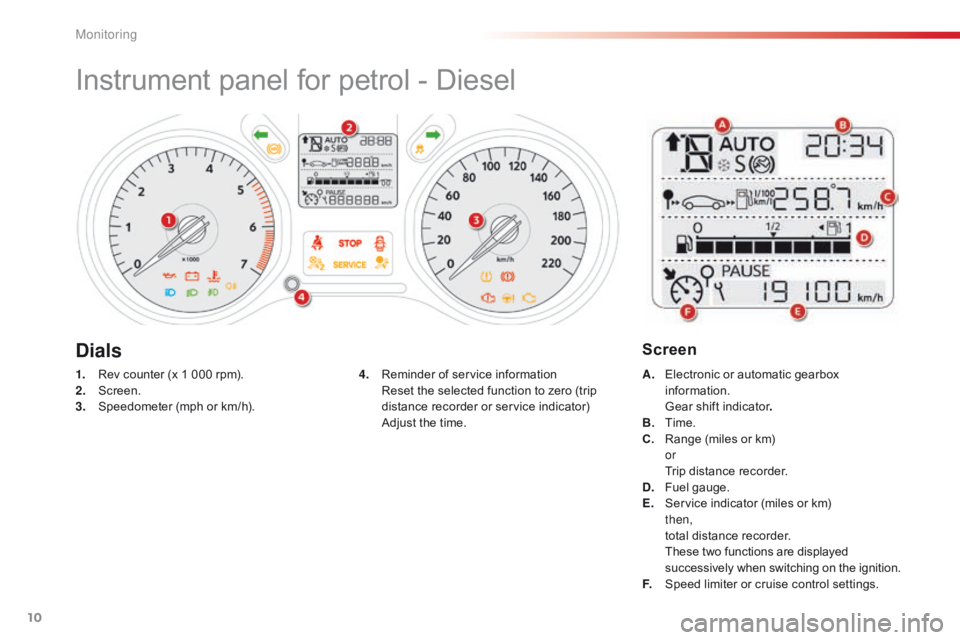
10
Instrument panel for petrol - Diesel
1. Rev counter (x 1 000 rpm).
2. Screen.
3.
S
peedometer (mph or km/h). A. E
lectronic or automatic gearbox
information.
G
ear shift indicator.
B.
T
ime.
C.
R
ange (miles or km)
or
T
rip distance recorder.
D.
F
uel gauge.
E.
S
ervice indicator (miles or km)
then,
t
otal distance recorder.
T
hese two functions are displayed
successively when switching on the ignition.
F.
S
peed limiter or cruise control settings.
4. R
eminder of service information R
eset the selected function to zero (trip
distance recorder or service indicator)
A
djust the time.
DialsScreen
Monitoring
Page 79 of 330

77
Cruise control
System which automatically maintains the
speed of the vehicle at the value programmed
by the driver, without any action on the
accelerator pedal.
The cruise control is switched on manually: it
requires a minimum vehicle speed of 25 mph
(40 km/h), as well as the engagement of:
-
f
ourth gear on a manual gearbox,
-
s
econd gear on a or automatic or electronic
gearbox, in sequential mode,
-
p
osition A on an electronic gearbox or
position D on an automatic gearbox.
The cruise control is switched off manually
or by pressing the brake or clutch pedal or
on triggering of the ESP system for safety
reasons.
It is possible to exceed the programmed speed
temporarily by pressing the accelerator pedal.
To return to the programmed speed, simply
release the accelerator pedal.
Switching off the ignition cancels any
programmed speed value. The controls of this system are grouped
together on stalk A
.
1.
C
ruise control mode selection thumb
wheel.
2.
V
alue decrease button.
3.
V
alue increase button.
4.
C
ruise control off/resume button.Steering mounted controls
The cruise control cannot, in any
circumstances, replace the need to
respect speed limits, nor can it replace the
need for vigilance on the part of the driver.The programmed information is grouped
together in the instrument panel screen.
5.
C
ruise control off/resume indication.
6.
C
ruise control mode selection indication.
7.
P
rogrammed speed value.
Displays in the instrument panel
5
driving
Page 80 of 330

78
F Turn thumb wheel 1 to the "CRUISE"
position: the cruise control mode
is selected but is not switched on
(PAUS E).
Programming
You can then change the programmed speed using buttons 2 and 3 :
- b y + or - 1 mph (km/h) = short press,
-
b
y + or - 5 mph (km/h) = long press,
-
i
n steps of + or - 5 mph (km/h) = maintained press. When the cruise control is switched on,
be careful if you maintain the pressure
on one of the programmed speed
changing buttons: this may result in a
very rapid change in the speed of your
vehicle.
do n
ot use the cruise control on
slippery roads or in heavy traffic.
On a steep descent, the cruise control
will not be able to prevent the vehicle
from exceeding the programmed speed.
To avoid any risk of jamming of the
pedals:
-
e
nsure that the mat is secured
c o r r e c t l y,
-
n
ever fit one mat on top of another.
In the event of a cruise control malfunction,
the speed is cleared resulting in flashing of the
dashes. Have it checked by a CITROËN dealer
or a qualified workshop.
Operating fault
Leaving cruise control mode
F Turn thumb wheel 1 to the "0" position: the cruise control mode is
deselected. The display returns to the distance recorder.
Exceeding the programmed speed
Intentional or unintentional exceeding of the programmed speed
results in flashing of this speed in the screen.
Return to the programmed speed, by means of intentional or
unintentional deceleration of the vehicle, automatically cancels the
flashing of the speed. F
S
et the programmed speed by
accelerating to the required speed,
then press button 2 or 3 (e.g.: 70 mph
(110 km/h)).
F
S
witch off the cruise control by pressing button 4
: the screen
confirms that it has been switched off (PAUSE).
F
S
witch the cruise control back on by pressing button 4 again.
Driving
Page 159 of 330

157
accessories
A wide range of accessories and genuine parts is available from the CITROËN dealer network.
These accessories and parts are all suitable for your vehicle and benefit from CITROËN's
recommendation and warranty.
"Comfort":
door deflectors, side blinds and rear screen
blind, smoker kit, portable scented air
freshener, boot dividers, coat hanger, armrest,
insulated module, reading lamp, cruise control,
boot storage, front and rear parking sensors,
glove box lid...
"Transport solutions":
towbars, towbar harnesses, canoe carrier, roof
bars, bicycle carrier on towbar, bicycle carrier
on roof bars, ski carrier, roof boxes, aluminium
roof rack....
"Security and safety":
wheel security bolts, child seats, breathalyzer,
first aid kit, warning triangle, high visibility vest,
snow chains, non-slip covers, foglamp kit, fire
extinguisher...
Tow bar, which mst be fitted by
CITROËN dealer or a qualified
workshop.
Advice on care and maintenance
Recommendations on the care and
maintenance your vehicle are given in the
maintenance and warranty guide.
"Styling":
gear lever knob, spoiler, parking brake lever
grip, spoiler, alloy wheels, foglamp trims,
chromed mirror shells, aluminium footrest,
chrome exhaust tailpipes, door sill finishers,
wheel trims...
9
Practical information
Page 161 of 330

159
MatsRemovable carpet protection.
When fitting the mat for the first time, on the
driver's side use only the fixings provided in the
wallet attached.
The other mats are simply placed on the
carpet.
FittingRemovalRefitting
To avoid any risk of jamming of the
pedals:
-
o
nly use mats which are suited to
the fixings already present in the
vehicle; these fixings must be used,
-
n
ever fit one mat on top of another.
The use of mats not approved by
CITROËN may inter fere with access to
the pedals and hinder the operation of
the cruise control / speed limiter.
To remove the mat on the driver's side:
F
m
ove the seat as far back as possible,
F
u
nclip the fixings,
F
r
emove the mat.
To refit the mat on the driver's side:
F
p
osition the mat correctly,
F
r
efit the fixings by pressing,
F
c
heck that the mat is secured correctly.
9
Practical information
Page 229 of 330

227
Door mirror adjustment 43 - 44
Deactivating the ESP/ASR
system
9
5
Opening the boot lid (depending on version)
3
7
Alarm warning lamp
3
4-35Instrument panels
1
0
Warning lamps
1
1-19
Service indicator
2
0 -21
Gear shift indicator
7
4
Distance recorders
2
2
Lighting controls
8
1- 85
Direction indicators
9
0
Horn
9
0
Instruments and controls (cont.)
Headlamp beam height adjustment 8
6 Wiper control
87
- 88
Trip computer
2
4-25
Speed limiter
7
5 -76
Cruise control
7
7-78
Steering wheel adjustment
4
5
.
Visual search